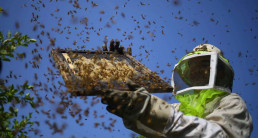‘The Insect Crisis: The Fall of the Tiny Empires that Run the World’ – Oliver Milman
It is Mother’s Day 2022, my husband is renowned for the selection of novel presents, and so I begin to carefully unwrap my gift, only to be greeted by the title ‘The Insect Crisis’ – slightly shocked by this year’s unusual present, I decided to give it a read, during those fleeting moments of toddler sleep, I found myself sucked into a disorientating (particularly considering the events of recent years), increasingly apocalyptic description of the world we currently inhabit.
The prologue is gripping and deeply depressing in equal measures, describing a lifeless world, devoid of colour, birds starving to extinction, in fact all manner of fauna and flora unable to co-exist – the world is painted as one of putridity – beetles absent, unable to breakdown decaying matter – millions of acres of land laid to waste. Descriptions of food supplies disintegrating – a third of global food production dependent upon pollination from not only the bees, but flies, moths, wasps and beetles. Common food items, such as apples, honey and coffee become scarce and expensive commodities. Strawberries, plums, peaches, melons and broccoli no longer able to be obtained, with remaining vegetables oddly-shaped and pathetically shrivelled. Starvation averted by a main stay of wind-pollinated wheat, rice and maize – beige plates now an order of the day.
As anyone who frequents my desk will know, the next description fills me with much alarm, in the absence of the pollinators of the cacao tree – chocolate supplies are now cut off! My attempt at lightening the mood, is met by descriptions of the slow starvation of the human race – once entire ecosystems collapse – this serves to accelerate said process.
The prologue ends as follows ‘Wild meadows vanished, followed eventually by tropical rainforests… Cascades of extinctions rippled through our denuded planet. For those of us left, the misery was finally complete’.

I am only three pages in at this point, and I am desperate to find answers. As a Landscape Architect, we seek to improve the natural environment, I am keen to learn more to inform my work and to help mitigate, prevent such a hellish existence from taking place. Biologist E.O. Wilson writes ‘Within a few decades the world would return to the state of a billion years ago, composed primarily of bacteria, algae and a few very simple multicellular plants’. There have been five mass extinctions in the past 400 million years, of which insects have survived all of these. Have we done so much damage since the industrial revolution, that now even the insects are in trouble?
In recent years, the Entomological world has pointed to major declines in the abundance and species diversity of insects around the world – often seemingly without cause. In 1970, Brad Lister, an Ecologist travelled to Puerto Rico to document its insects, rudimentary ‘sticky traps’ were set up – plates smeared with a sticky compound and distributed on the forest floor. By sunset, the plates were a blackened mass of insects – ready to be picked off, dried and weighed. Thirty-five years later, following up his work – the same experiment produced a handful of specimens. This happened day, after day – their results showed that 98% of insects by biomass had gone.
Similar studies from around the world echoed the same findings, such as ‘the total mass of the world’s insects receding at a breakneck speed of 2.5 percent a year’.

I think it is fair to say that we are all aware of the plight of the honeybees – who have become the poster child for insect decline in the public consciousness. Furthermore, in the United States, the abundance of four species of bumblebee has plummeted by as much as 96% in recent decades. Well-meaning budding beekeepers may be causing more harm than good, with poorly-managed honeybee hives being ‘little ecosystems of plagues and contagions’ according to Jane Memmott an Ecologist at Bristol University. By bringing in honeybees – bumblebees and solitary bees may inadvertently be starved due to the land required to sustain said honeybees. Honeybees require 45 kilograms of honey to get each colony through a year and it takes 2 million flowers to make half a kilogram of honey.
In 2019, scientists at the University of York, found that Moths, also important pollinators, are dropping in abundance by 10% each decade in Britain. British butterfly numbers have nearly halved in the past fifty years, whilst ‘more than twenty species of bees and flower-visiting wasps have completely vanished from the United Kingdom since the Victorian era’. The causes of said declines, almost certainly include habitat loss, exposure to pesticides and climate change.
Insects have long been seen in negative terms, as pests, as ‘creepy crawlies’. The often maligned wasp, has long been seen as a source of potential pain, a US study showed that wasps can grasp ‘transitive inference’ e.g. if A is greater than B and B is greater than C, then A must be greater than C. Sorting of insects into ‘good’ and ‘bad’ is therefore an unhelpful approach in understanding these complex creatures.
Aside from pollination and propping up the ecosystems of this planet (!) – insects and their derivatives have also been used for medicinal purposes for Millenia. Modern science is currently tapping into the great potential that insects hold in fighting diseases and antibiotic-resistance.
The UK is now considered to be one of the least wooded countries in Europe. Agricultural land now makes up nearly 3/4s of land cover. The drive for agricultural efficiency and techniques of modern farming have led to larger fields, half of all hedgerows have disappeared (key habitats for pollinators and insect predators of crop pests). Vital chalk grassland habitats have declined by 80%. A three-crop rule introduced by the EU, means that for much of the year, there is no crop growing at all, just barren soil – leading to the starvation of bees and other insects.
In the ‘Accidental Countryside’ Steven Moss argued that ‘modern agriculture would provide a better home for insects if it was bulldozed and replaced with houses and their gardens’. Britain’s gardens are often invariably more diverse than most arable fields.
Insects have also been devastated by the use of pesticides, the likes of Glyphosate, a commonly used poison that is regarded as a likely carcinogen – is currently being banned or in the process of being banned by a number of countries across the globe. Perhaps, most potent of all are unsurprisingly, the insecticides. The now banned DDT has been eclipsed by the current use of neonicotinoids, which has been calculated to be 7,000 times more toxic to bees than DDT. Dave Goulson claims ‘a single teaspoon of imidacloprid is enough to kill as many honeybees as there are people in India’.
I have summarised a small section of the 260 pages of this fear-inducing and eye-opening book, what can we now do, it is important that certain chemicals are restricted and sufficient, joined up land (even at the margins) be given over for insects to repopulate.
Examples of rewilding projects such as at Knepp – a system of nature-based farm management – allowing the tools of nature to reinvigorate the landscape to become a more common occurrence. Wildlife corridors are imperative, especially in relation to climate change. Buglife, have modelled ‘B-Lines’ a grand ambition for 3,000 miles of insect corridors comprising wildflower habitats.
In urban environments, green and brown roofs are showing great promise in supporting insect life, with some reports demonstrating greater levels of biodiversity than the brownfield sites which they are replacing. Ensuring that more space is given over to ‘green infrastructure’ – creating valuable, connected habitats in both rural and urban contexts.
At a domestic level, reducing the number of times we mow or weed our lawns or use outdoor lighting can help, as well as a reduction in the use of chemicals in a garden setting.
The insect crisis, is really a human emergency, and it is important that we act now, globally.
